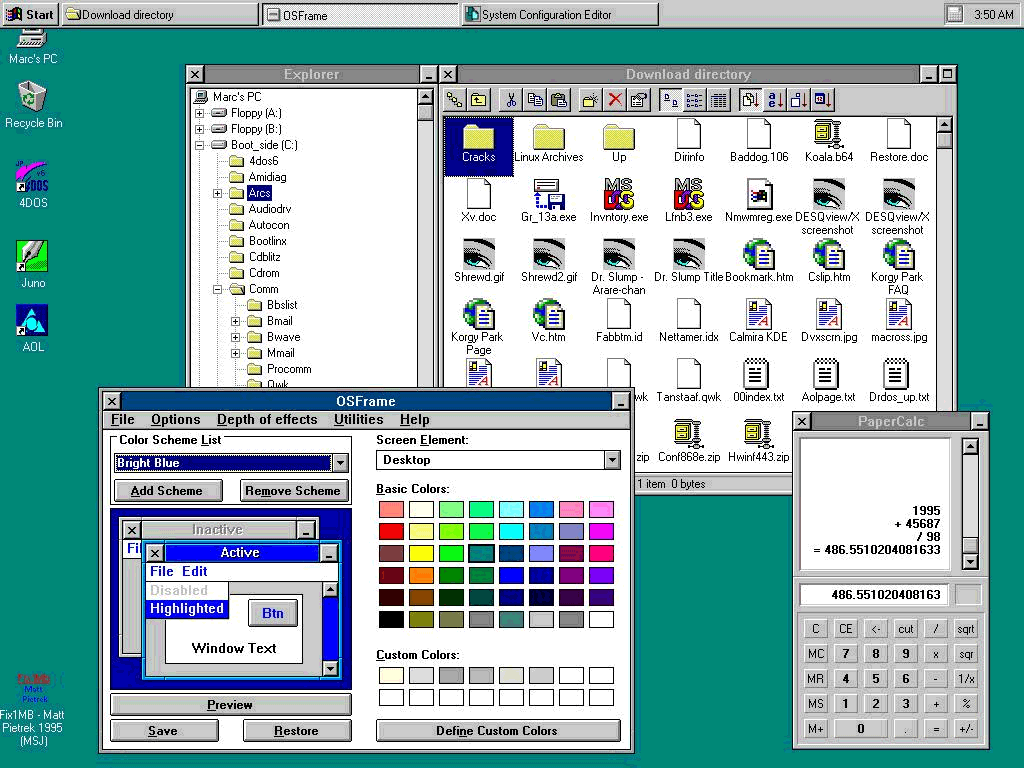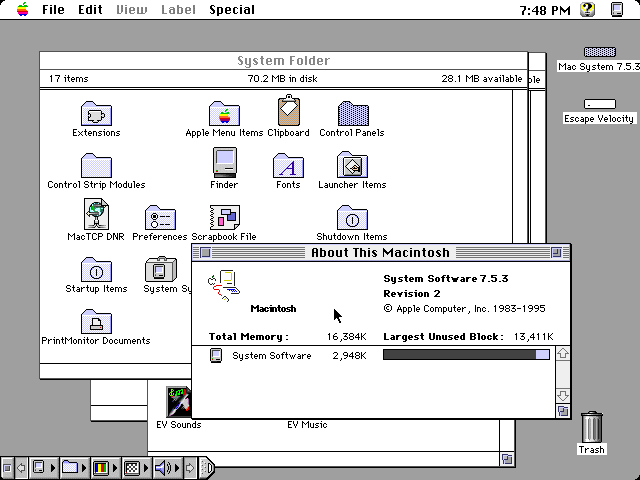I haven’t always been a Mac user. I started my computing days out on a Commodore 64 and an Acorn 3010.
I bought my first PC from my employer in 1997 – a massive, heavy beige tower containing a 486DX2-66 processor, 64 MB RAM, 500 MB hard drive, a CD-ROM drive, and a 15″ SVGA monitor.
When I got it, it was running Windows 3.11. It never ran properly – due to a lack of correct graphics drivers, it only ran with 256 colours. I bought a Windows 95 disc and set about installing it. It was a second generation Service Release B Windows 95 disc with built-in support for USB and FAT32, something the original release version didn’t have. I had only played with Windows 95 prior to this for about half-an-hour on a friend’s brand new computer, and I was in awe.
 Windows 95
Windows 95
The install went very well. There was very little in the way of hardware in my machine, and the Windows install disc found everything. To my surprise and delight, it detected the graphics chip and brought it to life, correcting the colour and driver issues I had before.
It was very fast, and compared to the clunky Windows 3.11 it replaced, it was slick and easy to use. Apple was still using System 7 when Windows 95 was released, and while it made Windows 3.11 look a bit outdated, the release of Windows 95 spun that around, making the long-running System 7 look old.
 Macintosh System 7.5.3 from 1995.
Macintosh System 7.5.3 from 1995.
18 months later I sold that PC for a custom made tower running Windows 98.
Windows 95 was a massive leap forward in terms of technology and usability. The graphic interface was completely rewritten, a design that would carry through almost in its exact form until Windows 2000. Windows XP bloated out the UI with pretty and bold colours, but it was still based on Windows 95.
It wasn’t until Vista was released that Microsoft would change the look massively. The Start menu has changed in Vista and 7 – but still with underpinnings stemming from Windows 95. The Task Bar has remained largely the same since Windows 95.
The jump from a 16-bit operating system to a primarily 32-bit OS and a whole new driver and hardware structure made Windows 95 a massive leap in computing. It was the start of a long road of easier-to-use computing. It was breaking the nerdy mould of computing and bringing it to the masses, bringing it to the average person.
Windows 3.11 was fairly stable, but due to the nature of Windows as a shell running on top of MS-DOS, if an app crashed, it would generally bring the whole OS down. This changed in Windows 95, which was not built on top of DOS; an app crash would mostly be isolated, and force quitting the app would leave the rest of the OS intact.
Windows 95 Launches
Windows 95 was a major turning point for Microsoft. A lot rested on its success. The launch and promotional material featured some major stars, including The Rolling Stone, Jennifer Aniston, Matthew Perry, and Weezer. They really wanted to grab the world’s attention – and that they did.
Windows 95 was the success that Microsoft wanted. It did grab the attention of the world, and it did bring computing to the masses.
Tired Old Mac System 7
It also put a lot of pressure of Apple. Despite having a stable and fast OS with System 7, it now looked dated, it didn’t look as slick as Windows 95, and it would be the start of a long struggle for Apple to compete with Microsoft.
Even when Mac OS 8 and OS 9 were released, the Mac platform still looked a little tired. By the time Mac OS X was released in 2001, Microsoft had released Windows 98, 98SE, ME, 2000, and XP – bloating more and more with each release but all looking increasingly prettier. This might sound a little daft to compare an OS on its looks, but the general public do.
Those not so nerdy amongst us wanted an easier, prettier OS and would be sucked in by wild claims of easier use, plug-and-play hardware detection, rock solid stability, and greater compatibility – even if they weren’t entirely true. This is increasingly true today as we enter the era of a more iOS based Mac operating system and the release of Windows 8 with its Metro touch-centric interface.
It wasn’t until the turn of the century when Apple really stepped up its marketing. Today it can produce anything and sell it by the millions with clever marketing and tag lines. Apple is the slick and clean technology company that creates must-have gadget.
However, in the middle-to-late 90s, this was Microsofts domain. It was a pinnacle point in home computing that could have gone either way, but it was Microsoft who had the marketing edge and has made them the success they are today.
Mac OS X was Apple’s Windows 95. Compared to OS 9, it was gorgeous to look at and slick; it was Apple’s turning point. That said, I became an Apple user because I preferred the Mac OS. Mac OS 9 may not have been all glitzy and shiny compared with Windows 95 and 98, but it was fast and “it just worked”. With each subsequent release of Windows, I got increasingly infuriating with its instability, bloatedness, and needing drivers for everything – and then hardware clashing with other pieces of hardware. Each release saw a drastic shift in hardware requirements, despite Microsoft claiming it would run on minimal hardware, and it rarely did so.
Windows 95 was a huge jump in computing; it was one of the few Microsoft releases that was a joy to use, but since then it has been a slippery slope of boatedness. It is a true legacy. Microsoft dropped all support for it in 2001.
Why I Left Windows for Apple
I stumbled across the Mac platform at work in 1998 and was amazed. Even on the ancient hardware I was using it on, it was fast and it worked – since then I haven’t looked back. Within a few months I had ditched my 700 MHz Pentium III laptop running Windows 2000 for an old 300 MHz Beige G3 tower running Mac OS 9.2. Surprisingly, there wasn’t mach difference in general operating speed – a true testament as to how streamlined classic Mac OS was.
I still have Windows-based machines in my house. My kids have a Windows XP tower, and my wife has a Windows 7 laptop – and both infuriate me. After using a Mac for over 13 years, the simplicity and ingenuity of it makes it feel so natural. When I have to use or maintain the Windows machines, I find myself getting very frustrated by their clunkiness, their awkwardness, and the stupid problems that come up on them. It reminds me of why I use a Mac.
Occasionally I play with Windows in virtual machines on my Mac using VirtualBox. I recently installed Windows 95 just to reminisce.
While Windows 95 was great way back then, I could never find myself going back to Windows for everyday use. Its Mac or nothing for me.
Follow Simon Royal on Twitter or send him an Email.
Like what you have read? Send Simon a donation via Tip Jar.
keywords: #windows95 #microsoft #techspectrum #simonroyal
short link: http://goo.gl/wUSX9B
searchword: windows95

